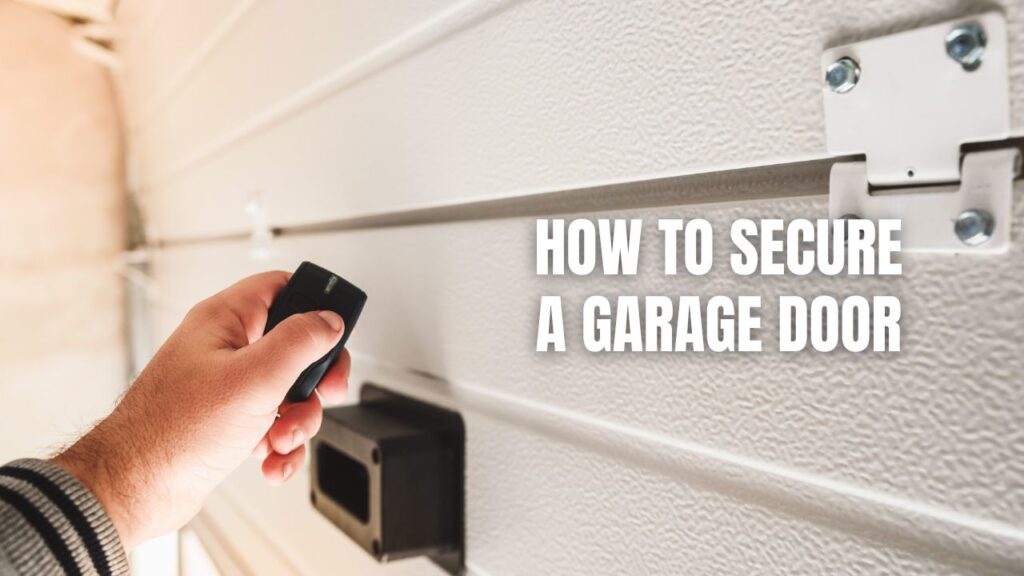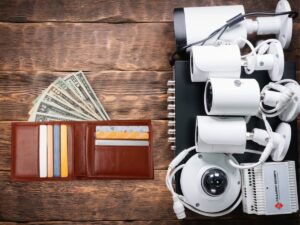Securing a garage door involves multiple layers of protection, including physical locks, smart technology, and security reinforcements. Installing manual and electronic locks, using smart plugs, adding security cameras, and reinforcing garage entry points can significantly reduce the risk of break-ins.
Our garage doors serve as a main entry point to our homes, making them a prime target for intruders. While many homeowners focus on securing their front and back doors, the garage is often overlooked. The good news? There are simple yet effective ways to secure a garage door and prevent unauthorized access.
Key Takeaways:
- Prevent fishing attacks by securing the emergency release cord.
- Install manual locks to reinforce security.
- Use smart plugs to disable automatic openers when away.
- Add a security camera with floodlights for monitoring.
- Secure garage side doors with smart locks and deadbolts.
- Use track locks to prevent manual lifting.
- Lock L-shaped bars on both sides to prevent forced entry.

Preventing Fishing Attacks
What is Garage Door Fishing?
Garage door fishing is a common burglary tactic where a thief slides a wire hook through the top gap of the garage door, targeting the emergency release cord to disengage the opener. This allows them to manually lift the door.
How to Stop Fishing Attempts:
- Zip Tie the Emergency Release Lever – A simple zip tie prevents the cord from being pulled.
- Wrap the Pull Cord Around the Rail – Keeping it out of reach makes fishing attempts ineffective.
- Install a Garage Shield – A garage shield blocks access to the release mechanism entirely.
Installing a Manual Locking System
A garage door opener alone isn’t enough. A manual lock adds an extra layer of security.
Best Manual Locking Solutions:
- Hasp and Padlock – Mount a hasp at the bottom of the door and use a heavy-duty padlock.
- Lateral Garage Locks – These slide bolts prevent the door from being lifted.
- Interior Slide Locks – These attach inside the door, blocking the tracks from movement.
- Loop Welding – If you have a metal garage door, welding loops on each side allows you to secure the door with padlocks.
Using Smart Plugs for Added Security
How Do Smart Plugs Secure a Garage Door?
A smart plug cuts power to the garage door opener, preventing it from being remotely activated by thieves using code grabbers.
Benefits of Smart Plugs:
- Remote Access – Control the power from anywhere via an app.
- Scheduled Shutoffs – Set it to disable during nighttime hours.
- Prevent Hacking – Stops unauthorized remote access to the garage opener.
Adding Security Cameras with Floodlights
A visible security camera acts as both a deterrent and an evidence-gathering tool.
What to Look for in a Garage Security Camera:
- Motion Detection – Sends alerts when activity is detected.
- Two-Way Audio – Lets you communicate with intruders.
- Night Vision – Ensures clear footage in the dark.
- Cloud Storage – Saves footage for future reference.
Securing Garage Side Doors
Many break-ins happen through the side door rather than the garage itself.
How to Reinforce Garage Side Doors:
- Install a Smart Lock – Allows remote locking and unlocking.
- Use a Deadbolt – Prevents forced entry.
- Reinforce the Door Frame – Use metal strike plates and longer screws.
- Add a Peephole Camera – Lets you monitor activity outside the door.
Using Track Locks to Prevent Manual Opening
Track locks are physical stoppers that block the door from sliding up.
Installing a Track Lock:
- Position it beside the garage door track.
- Slide the bolt into the track’s slot when locking.
- Use a padlock to keep it secured.
Locking L-Shaped Bars for Extra Protection
L-shaped locking bars are found on the edges of the garage door. If yours doesn’t have them, check for holes in the tracks where padlocks can be used.
How to Secure L-Shaped Locking Bars:
- Slide the bars into the designated slots.
- Use padlocks on both sides.
- Ensure there’s no gap wide enough to lift the door.
Additional Security Measures:
- Frost or cover garage windows – Prevents intruders from seeing inside.
- Install a security alarm system – Alerts you to any unauthorized entry.
- Keep garage doors closed at all times – Even when home.
- Upgrade to a rolling code garage door opener – Prevents hackers from stealing access codes.
FAQs
Can burglars break into my garage door opener system?
Yes, if your garage opener uses an outdated fixed code system. Upgrading to a rolling code opener prevents hacking attempts.
How do I make my garage door opener hack-proof?
Use a smart plug to disable power when away, and upgrade to a rolling code system to prevent code grabbing.
Should I install a garage door security bar?
Yes. A security bar physically blocks the door from being lifted, adding another layer of protection.
How can I secure my garage door during a power outage?
Manually lock the door with slide bolts, padlocks, or track locks to prevent forced entry.
Do garage doors need additional security even if I have an alarm system?
Yes. Garage doors are a weak point. Adding cameras, smart locks, and manual reinforcements ensures full protection.
Fortify Your Garage Door Like a Pro
A garage door can be a major security vulnerability, but with the right measures in place, we can turn it into a fortress. By combining manual locks, smart technology, and surveillance, we ensure our homes stay safe from potential threats. Don’t wait until it’s too late—secure your garage door today!
Contact Callaway Security™ for home security systems needs!












